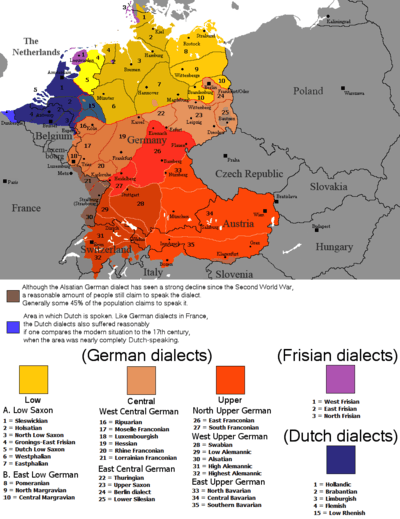High German languages
The High German languages or High German dialects (German: hochdeutsche Mundarten) comprise the varieties of German spoken south of the Benrath and Uerdingen isoglosses in central and southern Germany, Austria, Liechtenstein, Switzerland, and Luxembourg, as well as in neighbouring portions of France (Alsace and northern Lorraine), Italy (South Tyrol), the Czech Republic (Bohemia), and Poland (Upper Silesia). They are also spoken in diaspora in Romania, Russia, the United States, Brazil, Argentina, Mexico, Chile, and Namibia.
| High German dialects | |
|---|---|
| Geographic distribution | German-speaking Europe |
| Linguistic classification | Indo-European
|
| Subdivisions | |
| Glottolog | high1289[1] |
The High German languages are marked by the High German consonant shift, separating them from Low German and Low Franconian (Dutch) within the continental West Germanic dialect continuum.
Classification

As a technical term, the "high" in High German is a geographical reference to the group of dialects that forms "High German" (i.e. "Highland" German), out of which developed Standard German, Yiddish and Luxembourgish. It refers to the Central Uplands (Mittelgebirge) and Alpine areas of central and southern Germany; it also includes Luxembourg, Austria, Liechtenstein and most of Switzerland. This is opposed to Low German, which is spoken in the lowlands and along the flat sea coasts of the North German Plain.[2]
High German in this broader sense can be subdivided into Upper German (Oberdeutsch, this includes the Austrian and Swiss German dialects), Central German (Mitteldeutsch, this includes Luxembourgish, which itself is now a standard language), and High Franconian German, which is a transitional dialect between the two.[3]
High German (in the broader sense) is distinguished from other West Germanic varieties in that it took part in the High German consonant shift (c. AD 500). To see this, compare English/Low German (Low Saxon) pan/Pann with Standard German Pfanne ([p] to [p͡f]), English/Low German two/twee with Standard German zwei ([t] to [t͡s]), English/Low German make/maken with Standard German machen ([k] to [x]).[4] In the southernmost High Alemannic dialects, there is a further shift; Sack (like English/Low German "sack/Sack") is pronounced [z̥ak͡x] ([k] to [k͡x]).
History
Old High German evolved from about 500 AD. Around 1200 the Swabian and East Franconian varieties of Middle High German became dominant as a court and poetry language (Minnesang) under the rule of the House of Hohenstaufen.
The term "High German" as spoken in central and southern Germany (Upper Saxony, Franconia, Swabia, Bavaria) and Austria was first documented in the 15th century. Gradually driving back Low German variants since the Early modern period, the Early New High German varieties, especially the East Central German of the Luther Bible, formed an important basis for the development of Standard German.[5]
Family
Divisions between subfamilies within Germanic are rarely precisely defined, because most form continuous clines, with adjacent dialects being mutually intelligible and more separated ones not. In particular, there has never been an original "Proto-High German". For this and other reasons, the idea of representing the relationships between West Germanic language forms in a tree diagram at all is controversial among linguists. What follows should be used with care in the light of this caveat.
- Central German (German: Mitteldeutsch)
- East Central German, including the Standard German variant[6]
- Thuringian
- Upper Saxon, including Erzgebirgisch
- Lusatian-New Marchian
- South Markish
- Lusatian
- Silesian (mostly spoken by the German minority in Upper Silesia)
- High Prussian, nearly extinct
- West Central German
- Central Franconian
- Ripuarian
- Moselle Franconian dialects, including Luxembourgish
- Hunsrik language (from the Hunsrückisch dialect)
- Rhine Franconian
- Palatine, including Lorraine Franconian (France)
- Pennsylvania German (in the United States and Canada)
- Hessian
- Palatine, including Lorraine Franconian (France)
- Central Franconian
- East Central German, including the Standard German variant[6]
- High Franconian, in the transitional area between Central and Upper German
- Upper German (German: Oberdeutsch)
- Alemannic, including Swiss German dialects
- Swabian
- Low Alemannic, including Alsatian and Basel German
- High Alemannic
- Highest Alemannic
- Bavarian, including Austrian German dialects
- Northern Bavarian
- Central Bavarian, including Viennese
- Southern Bavarian, including Mócheno in Trentino, Italy
- Cimbrian, nearly extinct
- Hutterite German (in Canada and the United States)
- Alemannic, including Swiss German dialects
- Yiddish, evolved from Middle High German
- Lombardic, extinct, categorization disputed
See also
References
- Hammarström, Harald; Forkel, Robert; Haspelmath, Martin, eds. (2017). "High German". Glottolog 3.0. Jena, Germany: Max Planck Institute for the Science of Human History.
- See the definition of "high" in the Oxford English Dictionary (Concise Edition): "... situated far above ground, sealevel, etc; upper, inland, as ... High German".
- Russ, Charles. The Dialects of Modern German: A Linguistic Survey. Routledge, 1989
- Robinson, Orrin. Old English and its Closest Relatives. Routledge, 1994.
- Russ, Charles. The German Language Today: A Linguistic Introduction. Routledge, 1994.
- "Ethnologue: East Middle German". Retrieved 2010-11-24.
Further reading
- Friedrich Maurer (1942), Nordgermanen und Alemannen: Studien zur germanischen und frühdeutschen Sprachgeschichte, Stammes- und Volkskunde, Strasbourg: Hünenburg, [designation of High German languages as Irminonic].